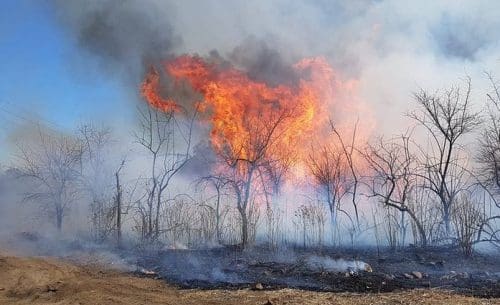 VICTORIAN farmers have been reminded of the importance of being prepared and having a bushfire plan in place for their livestock.
VICTORIAN farmers have been reminded of the importance of being prepared and having a bushfire plan in place for their livestock.
Agriculture Victoria said the impacts of the devastating 2019/20 bushfires included damaged fencing, and other infrastructure, facilities and supplementary feed stores, burnt pastures, and the devastating loss of thousands of sheep and cattle.
Producers were also required to move around 160,000 livestock to alternative locations across Victoria and interstate urgently both prior to, during and post the bushfires.
Now is the time for livestock owners to get prepared and have a clear strategy to apply in the possibility of a fire emergency on their farm, Agriculture Victoria said.
A key factor in minimising the threat to livestock during a bushfire or on extreme fire danger days, is to identify safer areas on-farm where livestock can be moved to. The area chosen will depend on the type of livestock and their expected behaviour during a bushfire.
Move livestock to a low-risk area
Agriculture Victoria said to reduce potential injury and death to livestock farmers should consider relocating stock to designated low-risk areas during days of high fire danger and Total Fire Bans. Low risk areas can include:
- ploughed paddocks, areas cultivated and kept free of combustible vegetation
- bared-out paddocks, provided they are well defended by fire breaks
- irrigated paddocks or paddocks containing green summer crops (green feed does not burn easily)
- stockyards that can be wet in advance. However, the yards must be well defended as the fire front passes.
All low-risk areas should have sufficient drinking water to enable stock to remain in the area for extended periods of high fire risk and high temperatures, be protected by firebreaks and be free of leaf, twigs and bark build-up. Areas where there are dams and swamps are another possible option, Agriculture Victoria said.
Click here for more information in regard to stock containment areas for emergencies .
Consider firebreak-protected stock yards
Agriculture Victoria said stockyards have been known to successfully hold livestock during a bushfire, if protected by a firebreak. If this is the preferred option, farmers should consider using a sprinkler system to minimise heat stress.
Horses should not be locked up in small areas or stables but moved to an open paddock with minimal vegetation, so they can move freely. Horses are good at moving themselves to safe open areas and usually suffer minimal burns if left to do so, but rugs, halters and flyveils can melt or burn them.
Don’t leave road gates open
Agriculture Victoria said it is crucial not to open gates that might allow stock access to public roadways, as any animals will be a hazard to traffic in smoky conditions.
On days of extreme fire danger or on the day before, stock should be moved into lower risk areas on-farm, or to a safer property.
Agriculture Victoria advises livestock owners to act early and not get caught trying to move stock as a bushfire approaches, listen to weather forecasts and observe your own environment to help you decide when to put your plan into action.
For further assistance on preparing a farm and livestock bushfire plan go to agriculture.vic.gov.au/agriculture/emergencies or contact the Agriculture Victoria Customer Service Centre on 136 186.
Source: Agriculture Victoria.

HAVE YOUR SAY